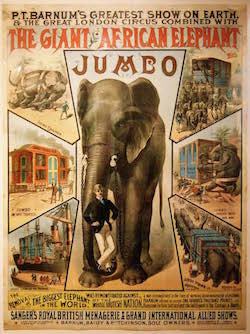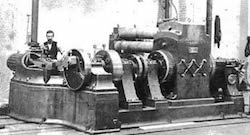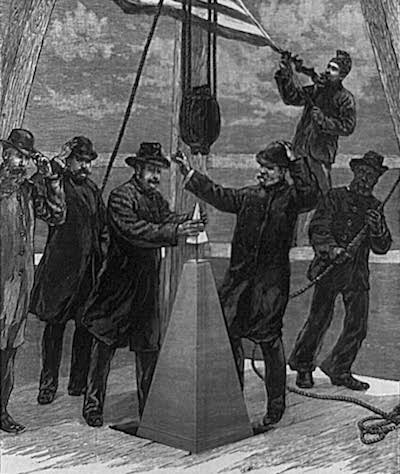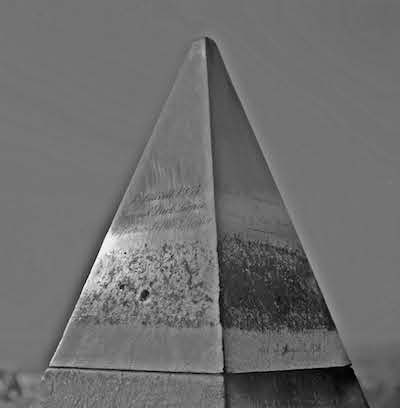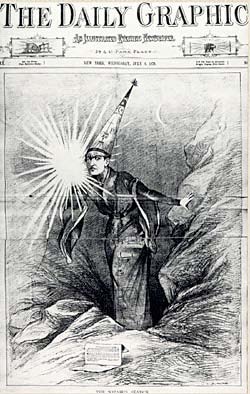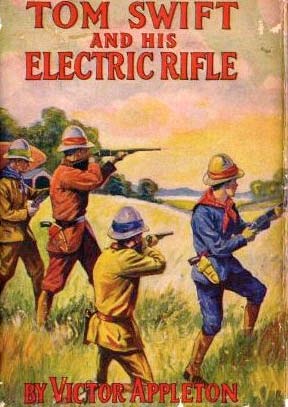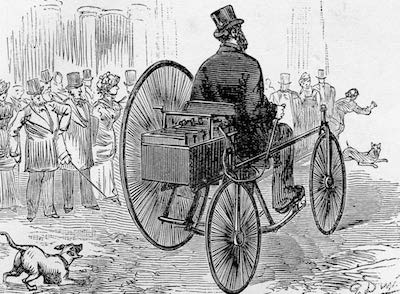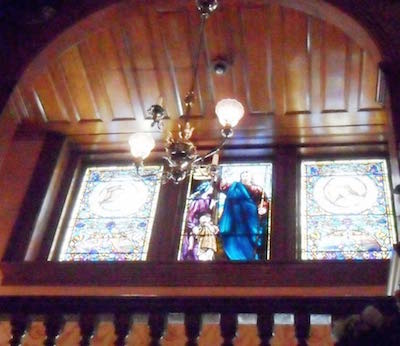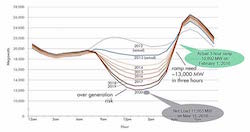Innovation, Feuds, Rivalry, and Revenge in the Never-ending Battle to Electrify America and the Planet
Jim Beall
The grid, acclaimed by some as “the supreme engineering achievement of the Twentieth century” (1), was actually born on September 4, 1882, when Thomas Alva Edison closed a switch, sending electrical power from a building at 257 Pearl Street to fifty-nine customers in downtown New York City. (2) That initial service area covered about one-quarter square mile in area and was chosen because, in addition to residences and businesses, it contained influential newspapers and major financial institutions whose support he would need to expand operations. The power was generated by a coal-fired engine driving a massive, twenty-seven-ton dynamo developed by Edison. He named it "Jumbo" after the famous elephant displayed by P. T. Barnum for the first time in Madison Square Garden five months earlier less than four miles away. (3)
|
Jumbo the Elephant |
Jumbo the Dynamo |
|
|
|
|
Image courtesy Wikimedia Commons |
Imagine courtesy National Park Service, Public Domain |
The electric power service met with such success that Edison was able to expand Pearl Street Station operations (eventually bringing on line five more boilers and "Jumbo" dynamos) to supply a full square mile of downtown Manhattan. Led by multi-millionaire J. P. Morgan himself, wealthy individuals outside of that tiny service area paid Edison handsomely to personally wire their luxurious residences and place generators on their property to ensure they had electricity. Crowds would congregate at night at the border fences to marvel at the illuminated estates glowing like beacons in the surrounding darkness.
Edison worked hard to promote his new service. Inspiration came from an unusual source: P.T. Barnum. The Brooklyn Bridge, which opened on May 23, 1883, was one and half times the length of the next largest suspension bridge in the world, and its size created much public concern concerning its safety. Soon after the bridge opened for traffic, a fear-caused panic led to the death of twelve people on the span. Barnum offered, and was allowed, to march Jumbo and twenty other elephants (and seventeen camels) across the bridge in an effort to put everyone's mind to rest as to the bridge’s structural soundness. The huge positive public reaction to the Brooklyn Bridge crossing led to Barnum parading elephants across more new bridges, including the iron Stratford Avenue Bridge at Bridgeport, Connecticut four years later. (4)
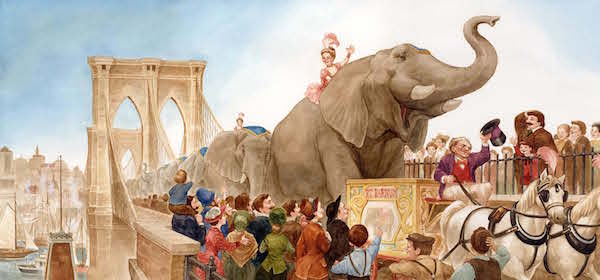
Source: Twenty-One Elephants (text by Phil Bildner, illustrated by LeUyen Pham; Simon & Schuster Children’s Publishing, 2004). Courtesy of Phil Bildner.
Edison, taking a leaf from Barnum’s playbook, marched a 400-strong contingent of Edison Electric Lighting Company employees through the dark streets of New York City as part of a Presidential campaign torchlight procession. Instead of torches, however, each wore a helmet topped by an incandescent bulb powered from a cable with electric wires running up one sleeve, out the collar, up the neck, and onto the bulb-helmet. The power for the cable came from the center of the formation: a complete horse-drawn, coal-fired, electric plant.

Source: The Thomas Edison Papers, http://edison.rutgers.edu/parade.htm
With free publicity from the New York Times (their premises now bright from electric lights) and capital from investors, Pearl Street Station was soon running at full capacity. Adding additional "Jumbos" would not allow additional expansion because voltage dropped off quickly with distance from the direct current (DC) generators. New stations were needed for areas farther than about one-half mile from 257 Pearl Street. Meanwhile, other towns and cities also became eager for electricity, and the obvious person to turn to was Edison. In fact, by 1887, he had opened 121 power stations.
The Current Wars Begin
New electrical entrepreneurs emerged and customers were free to contract with any of them such that multiple power lines were often run to the same building. While Edison's first service area was largely via underground conduits (5), those incurred permitting/construction delays and additional costs which made overhead lines simpler in the short term. Combined with urban density, this led to bewildering and dangerous scenes such as that shown in the following image from the streets of New York.

New York City street scene during the Blizzard of 1888.
Courtesy Wikimedia Commons. (6)
The most threatening competition to Edison and J. P. Morgan came in the form of a new way to provide electricity: alternating current (AC). Chief among those advancing AC were engineer/entrepreneur George Westinghouse partnered with theorist/inventor Nikola Tesla.
The showdown between AC and DC has been called "The War of the Currents" and saw many more stunts and flamboyant personalities. J. P. Morgan would throw vast sums at various investments and schemes (including wireless power transmission by AC power rival Tesla). The genius, cigar chain smoking, hunchbacked dwarf Charles Proteus Steinmetz would figure out the math of AC motors and also invent and demonstrate a device that spectacularly blew apart wood billets with man-made lightning. (7) Edison would clandestinely assist New York dentist Dr Alfred P Southwick in his development of the electric chair in efforts to convince the public that AC was too dangerous for normal use. (8) The first electrical execution was of murderer William Keller on August 6, 1890. Some members of the public did protest on the grounds of inhumanity, but it did little to stop the spread of AC power distribution.

Image source: New York Herald, August 7, 1890, courtesy of New York Public Library.
Despite all those large personalities, it was little known (outside of electrical engineering circles) William Stanley, Jr. who would decide the winner of the War of the Currents. (9) He would do so with the equally unimposing device below:

A transformer. (10) Image courtesy Richard Warren Lipack, Wikimedia Commons.
Electricity is best generated and used at relatively low voltages (100 volts or so), but electrical power transmission losses are far lower at much higher voltages. (11) As noted above, voltage drops and transmission losses limited DC grids to about one half-mile distance from each power plant. In effect, Edison's vision was for the nation to be a patchwork quilt of power plants each serving a tiny independent grid around it. Additionally, industrial loads such as electrical trolleys and other large motors that required higher voltages would have their own generators and wires.
In contrast, the AC approach pushed by Westinghouse allowed large power plants to generate great quantities of power, use transformers to convert (12) the power to high voltage for efficient transmission, and then use additional transformers near the consumer to reduce voltage again. Stanley's first demonstration was on March 6, 1886, when businesses and streets in Great Barrington, Massachusetts were lit with lamps at different candlepower settings from a generator almost a mile away via an AC line. Stanley's dream was to found an electric power company of his own to compete with Edison and the others, but he would eventually put that aside and concentrate on building and improving transformers. (13)
The Aftermath of the First Current War
Within just a few years, it became clear that DC utilities made far less money than AC ones. With DC it was harder to add customers without dropping voltage, and the smaller boilers were inefficient and more costly to operate. Even though Edison's Pearl Street Station was initially a sole supplier, it took two years to turn a profit. If any lingering doubts remained among the general public and the investor community as to the superior approach, the first Westinghouse's Niagara Falls hydropower generators settled it in 1896 when they began supplying AC power to Buffalo, New York, twenty-five miles away. (14)
It did not take long for J. P. Morgan to conclude that DC had lost, and that AC was the future. He did not like losing money and Edison was forced out of the control of his own company. The financial titan then proceeded to play far dirtier than Edison (who had publicly electrocuted stray animals and even a circus elephant with AC) ever had. (15)
Morgan sent in the lawyers.
With his bottomless pockets (16), he threatened to tie Westinghouse, Stanley, and everything and everybody else up in patents litigation until all but he were broke. In the end, mergers and deals left Morgan's General Electric (Edison's name was dropped) controlling about seventy-five percent of the electricity market and Westinghouse most of the rest, with nearly all of it AC. (17)
As the decades passed, the price of electricity dropped at an astonishing rate. Edison's first bill (18) went to a brass and copper company in early 1883 for a few cents over $50, equivalent to approximately $1100 in 2017 dollars! As the first provider, Edison obviously had no competition, and so set his prices to compete with gas-piped lighting. Initially, demand vastly outstripped supply as more and more communities became electrified and businesses replaced expensive on-site boilers (and other sources of mechanical power) with more efficient electricity. As the twentieth century began, demand continued to expand as new devices appeared, such as elevators, trolleys, and large industrial motors. Meanwhile, economies of scale inherent in large AC power stations and transmission (along with related technological advances) brought down costs on the generation side. The cumulative result was that by 1920 the price of electricity had fallen to one-fifth of what it had been at the dawn of the century. (19)
To get a sense of the effect that electric motors had on industrial operations, one need only compare large scale pre-electric manufacturing with the electrified conditions that replaced them. The earlier method was to have a large steam engine whose main shaft was connected to several other shafts that traversed the ceiling above the working floor. These secondary shafts would have a great many pulleys mounted on them, each driving a belt dropping to an individual machine on the working floor. The result was a loud, congested, and dangerous working environment. Here’s a video that gives a glimpse of the old, belt-driven process.
The introduction of electric motors completely changed manufacturing techniques which, in turn, changed the layouts of factory floors and greatly improved working conditions. In addition, overhead electric lights ensure good working visibility, and electric fans enhanced ventilation.
Affordable bulk electricity did far more than simply revolutionize factories via the introduction of motors. Perhaps one of the greatest involved the most common metallic element in the Earth's crust (8%) but whose refining had always been so difficult and costly that it was mostly used in expensive jewelry. In its pure form it is a shiny, "ghostly" light metal that does not tarnish: aluminum. When the U.S. Army Corp of Engineers needed a "perfect" material for the apex of the Washington Monument, the performance requirements and the desire to be impressively unique made aluminum by far the best choice. Indeed, the nine-inch, 100 ounce pyramid casting was, in 1884, the largest piece of aluminum in the world. (20)
|
|
|
|
Image courtesy National Park Service. |
Photo from the 1934 repair. Courtesy Wikimedia Commons. |
Niagara's very first power delivery (contract amount of 1,500 horsepower) began in 1895, a year before Buffalo got its long-distance power from the same generator, to the Pittsburgh Reduction company. The founder of the company was inventor Charles Martin Hall, who had perfected and patented the revolutionary electrolysis process still used today to refine aluminum. For that, however, he needed electricity and plenty of it. Westinghouse had all of Niagara Falls to work with, and more generators were soon brought on line. Bulk electricity allowed Hall and The Pittsburgh Reduction Company to produce lots more aluminum. (21)
The price of aluminum dropped and its availability improved dramatically over the next few years. In fact, the availability improved so much that, unable to find any automobile engine manufacturer able to meet their performance requirements (at least 8 horsepower and no more than 180 pounds), Wright Brothers' "mechanician" (as he called himself) Charlie Taylor turned to Pittsburgh Reduction for a block of aluminum and machined an engine himself with an aluminum crankcase. It weighed 178 pounds, produced twelve horsepower, and was what powered the Wright Brothers into aviation history. Continued improvements in aluminum accessibility and price due to cheap bulk electricity from the grid would fuel the vast expansion of aviation in the decades to come.
Wizards and Politicians
Increasingly enormous quantities of electrical power were demanded by residences, businesses, and all sectors of industry. The need for massive central power stations led to damming great rivers, and building numerous and increasingly large fossil fuel power plants. (22) The selection of sites for new industrial facilities, including the locations of Oak Ridge and Hanford by the Manhattan Project during World War II, were based on access to electrical generation capacity. The total quantity of electrical power generated in the United States in 1902 (the first date of reliable statistics) was about 6 gigawatts. Look at how production grew:
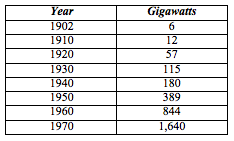
Source: Historical Statistics of the United States, Colonial Times to 1970, US Census, Table Series S 32-43
In popular culture during this period, electricity progressed from magic (Edison was labeled the Wizard of Menlo Park, while Steinmetz was called the Wizard of Schenectady) to science fiction "handwavium."
|
|
|
|
The Daily Graphic, November 15, 1879 Courtesy Thomas Edison Papers, |
Tom Swift and His Electric Rifle, 1911 Source: Author's Collection |
Inventors produced devices that sound like bad fiction but were quite real. Two examples below are Gustave Trouvé's 1881 asymmetrical tricycle (23) and the combined gasoline vapor and electricity chandeliers (the "candles" in the photo are actually ceramic jets with gas and wires both running down the common supply tube from the ceiling). (24)
|
|
|
|
Source: Jacques Cattelin, Wikimedia Commons—Public Domain |
Maymont Chandelier Source: Author's Collection |
Science fiction authors' handwavium uses for electricity included powering weapons, spaceships, and galactic empires. Jules Verne's Nautilus was powered by electricity, for example, while Britain's best-selling pre-WWI author Marie Corelli repeatedly cited the “Electric Principle of Christianity" in her break-out novel, A Romance of Two Worlds (1886). The use of electrical power from hydro generators and fossil fuel soon became so pervasive and commonplace, however, that authors shifted to other and more exotic sources (e.g., nuclear generation).
As power plants grew in size, the largest and most efficient generators let their owners out-compete others. This led to the number of providers in an area dropping through mergers or takeovers, and industry consolidation began to trend towards geographical monopolies. With memories of the railroad monopoly abuses of the 1870s, the governors of Wisconsin and New York in 1907 signed into law measures to establish regulations on the electric industry within their states. By 1914, forty-five of the forty-eight States had established some form of government oversight of electric utilities.
The continued growth of the electrical industry led to perhaps an even faster growth in laws, regulations, and governmental oversight bodies. Municipalities created their own generation facilities; public utility commissions regulated rates of return; and the Federal Power Commission (FPC founded in 1920, replaced by the Federal Energy Regulatory Commission, or FERC, in 1977) regulated interstate electrical matters. Others include the Nuclear Regulatory Commission (NRC), the Securities and Exchange Commission (SEC), Federal Emergency Management Agency (FEMA), Environmental Protection Agency (EPA), the Department of Energy (DOE), and the Federal Communications Commission (FCC). All of these organizations required staffing with full-time engineers, bureaucrats, and political appointees.
The cumulative effect is that the difficulties faced by Edison in 1882 in getting local government permission to dig up streets around Pearl Street Station for underground conduits have been dwarfed by the impacts of the maze of local, State, and federal bodies, regulations, and laws that have to be negotiated to build a new power plant, lay a new transmission line, etc. (25) This plays a major role in the decision-making of electric utility companies, who themselves established departments to deal with the regulators.
The Dawn of Grid War Two
More recent inventions and technological advances suggest that a second War of the Currents may have begun, some even use phrases like "Edison's Revenge." (26) Four major contributors to this situation are:
1) High Voltage DC (HVDC) power transmission,
2) Solid state devices for DC—AC conversion,
3) DC device proliferation, and
4) New sources of distributed DC generation.
As noted earlier, AC prevailed over DC in the nineteenth century because AC could be cheaply transmitted at high voltages over great distances and then distributed locally at useful lower voltages because of William Stanley's transformers, while DC had no such equivalent device. There are several theoretical advantages to DC transmission but the advantages are small (27) unless the distances are very great (even a hundred miles is not far enough) or includes a submarine cable (the water adds significant impedance to the constantly varying AC). The first inventions that accomplished this conversion (e.g., the "mercury-arc valve") were used in several high voltage direct current transmission projects in other countries, perhaps most notably the Cross Channel Project between England and France. There were enough challenges that such lines remained few and special purpose.
The invention of the transistor in 1947 by Bell Labs led to many more solid-state devices. These electronic components would become the heart of equipment much more useful for changing DC to AC (inverters) and from AC to DC (rectifiers). Combined with great distances, power, and voltages, Ultra-high voltage DC transmission lines have been built in many places around the world. The most favored applications have been to transmit power from distant mines (avoiding coal transport while keeping the combustion distant from cities) and hydropower sites. (28) Below are a few examples:

(By comparison, U.S. typical AC lines are 345 kV or 500 kV)
Due to geographical factors, China, in particular, is pushing Ultra HVDC lines, with many more projects still under construction. Three-quarters of China’s coal deposits are in the far north and northwest of the country, while four-fifths of its hydroelectric power is in the southwest. Most of the country’s people, however, are in the east, 2,000 km or more from these potential energy sources. One HVDC line in the U.S. is the 1,362-kilometer Pacific DC Intertie sending Columbia River hydropower from Oregon to Los Angeles. In operation since 1970, it has been modified and upgraded several times. It presently operates at 500 kilo-Volts with a capacity of 3,100 megawatts.
Wind turbines and photovoltaic (PV) solar panels have become two of the most significant contributors among new technologies to produce electrical power. One especially attractive application of solar PV is to recharge DC devices directly, without connecting to the grid at all.
The Rural Electrification Act (REA) of 1936 was one of the many New Deal measures signed into law by President Franklin D. Roosevelt during the Depression. By then towns and cities mostly had electricity, but farms and rural communities did not. The mission of the REA was to connect such remote areas to the grid, but the Depression and World War II both slowed efforts. Fueled by the post-war economic expansion in both the national economy and government budgets, all but a statistically few U.S. households were connected to the gird before the end of the 1950s.
Ample and largely dependable electrical power revolutionized American lifestyles with refrigerators, air conditioning, stoves, etc. Even house designs changed, as window area and natural light diminished in importance. Tall buildings became more feasible as apartment houses, due to reliable elevators and other building support services. Electricity had progressed from fantasy magic, to science fiction handwavium, to ultra luxury, to commonplace tool, to absolute necessity.
U.S. warship designers followed a similar path, including dependence on electricity, in effect creating individual ship-wide grids. When the author's USS Long Beach (CGN-9) was berthed alongside USS Chicago (CA-136) in the mid-1970s, the engineering departments traded propulsion plant tours. Both ships had similar armament and other capabilities, but the refurbished late-WWII cruiser still retained a lot of legacy steam-powered machinery, enabling it to operate and drive through the ocean without electricity (though radars, etc. would not work). Without electricity, the author's much more modern nuclear cruiser was dead in the water and unable to operate almost anything at all. With the need for artificial gravity and life support, space dreadnoughts might have it even worse.
The Grid Spawns Visionary Fiction
Authors had long used earthquakes, tsunamis, volcanoes, meteor strikes as mega-disaster events. A new catastrophe began appearing in fiction: loss of the grid.
Post-apocalyptic fiction was hardly new. H. G. Wells' 1895 novel, Time Machine, premised a future knocked back to pre-civilization technology due to war. Even post-nuclear war rebuilding from low technology was not new, starting perhaps with Nevil Shute's 1957 novel, On the Beach, inspired by the Castle Bravo thermonuclear bomb test gone wrong at Bikini Atoll in 1954. Innumerable other stories since have been written along similar lines.
Loss of grid plotlines differed, however, as many times only electricity was affected. The transition perhaps began with Warday, the 1984 novel by Whitley Strieber and James Kunetka, in which the story highlighted the first damage from nuclear bomb electrical magnetic pulse (EMP) effects, but then separate, limited nuclear missile attacks followed with the more "traditional" destruction. More recently, William R. Forstchen's 2009 novel, One Second After, concentrated on how people in the U.S., deprived of the grid by EMP attack, would struggle to survive and rebuild. (29)
Improvements in PV and wind now allow many who are isolated to have electricity without the grid. Some, in fact, erect their own wind and PV generators and actively avoid the grid (living "off-grid") while still managing to have electricity for refrigeration, television, and devices. The increasing portability of solar chargers, packable wind turbines, and rollable PV sheets allow even backwoods campers ways to have electricity almost anywhere. The massive surge in the availability of such devices may change how such grid loss scenarios would progress.
The Grid and the Green Duck
Both wind turbines and PV arrays can also add power to the grid, but these pose challenges, as well as opportunities. When they are in large enough groups, like wind farms or solar fields, they perform like more traditional power plants under optimum conditions of wind and sun. At other times, such as calm or night (or even in overcast conditions), they produce little or no electricity. The ratio of nameplate production to actual production is called the "capacity factor" of a power plant. For the last three years, the capacity factor for U.S. utility scale wind and PV solar facilities has averaged about thirty-four percent and twenty-six percent, respectively. Domestic nuclear plants, by comparison, averaged ninety-two percent during the same period. (30) When PV and wind are on-line, they provide the cheapest marginal cost power because the plants have already been built and the fuel is free.
When wind and PV solar are not available, however, customers either have to go without electricity or have it be provided by another source, such as fossil fuel plants or batteries. This situation has been well covered in many other places, but one aspect may come as more of a surprise. Specifically, a service area (or country) that is heavily reliant on wind and solar may end up with higher emissions than a comparable one that is less dependent! For example, Germany's emissions went up in 2015 due to small, less efficient fossil plants having to step in over and over again to supply the grid when wind and solar generators failed to meet demand due to weather (or lack of it). (31) If more of the base load is normally supplied by larger, more efficient fossil plants, the need for smaller, dirtier, and more expensive generation may be less frequent.
When weather conditions are optimum, however, these same renewable sources present an entirely different problem! Spot prices for electricity change constantly based on supply and demand. When generation changes constantly due to cloud cover or wind shifts, price volatility can become extreme. With full sun and/or strong winds, the price can drop to zero or even turn negative, meaning that grid operators have to pay someone to take the power. (32) These effects are very disruptive to markets. It provides a disincentive to utility companies considering the expense of building a new plant that might be needed to support area growth.
Extensive use of solar and wind to power the grid has revealed still another challenge named after a waterfowl: The Duck. It is a very large bird, indeed.
|
(Jumbo) the Duck |
Mallard the Duck |
|
|
|
|
Source: CAISO (33) |
Courtesy Wikimedia Commons |
Grid planners at the California Independent System Operator (CAISO) noted in 2013 a looming challenge. Using both historical and projected load data, they calculated the daily total electricity demand and subtracted from it the power produced by renewable generation (mostly solar). What they found was that renewable generation would rapidly push conventional generation off-line as the sun rose. Then, as the sun set, the need for that same conventional generation would return even more quickly, rising as much as 13,000 MW in three hours. The effect was made even more severe because the peak total demand period was during and after sunset.
Under-generation means brown-out/black-out risks, while over-generation means excess power requiring paying others to take the power or emergency shutdown of plants that would somehow need to get back on line a couple hours later. The Duck was predicted to keep growing larger, which CAISO recognized meant that mitigation measures needed to be found and implemented. Some of the ones proposed were finding/building/adding more flexible generators, increasing energy storage capabilities, and incentivizing customer habit changes. How effective they will be remains to be seen. California is hardly alone with this type of problem. (34) Basically, as grid penetration by solar increases, balancing generation and load becomes vastly more difficult with existing technology.
Conclusion
The grid has dramatically improved quality of life and continues to do so, as long as it is operating. Along the way it has generated not just electricity, but controversy—and oftentimes flat-out conflict. Over a century has passed since the first War of the Currents ended. But now the fight is over distributed DC versus central AC all over again. I don't know what Edison or Westinghouse or Tesla would make of it, but I'd bet anything J. P. Morgan would figure out how to make another fortune out of it.
Footnotes:
1,) The National Academy of Engineering, Constable and Sommerville, 2003. Reissued in book form as, A Century of Innovation: Twenty Engineering Achievements that Transformed our Lives. Washington, DC: Joseph Henry Press. https://doi.org/10.17226/10726
2) The switch itself was located in the in the office of J. P. Morgan, his first primary investor.
3) Edison was one of the early adopters of "Jumbo" as a brand naming device. Barnum's publicity campaign had begun even before the elephant got to the Garden. Crowds gawked as multiple teams of horses, two pusher elephants, and hundreds of men struggled to move Jumbo's enormous travel crate—with trunk sticking out and waving—up from the pier and down the five kilometers through the city to Madison Square Garden. The shows with Jumbo consistently sold out the 10,000-seat arena.
4) Web searches often misidentify photographs from the 1888 event on the Stratford Avenue Bridge as the Brooklyn Bridge one in 1884.
5) Getting permission to dig up the streets of New York City for 100,000 feet of wiring was probably the greatest challenge. In fact, Edison's proposal was initially rejected.
6) The heavy snowfall downed lines which, especially in the case of AC, led to several injuries and deaths.
7) Steinmetz, called "The Father of Electrical Engineering," built the lightning device simply to enable him to design and test lightning arrestors for transmission lines. Among his many textbooks and other publications is a book on relativity: Four Lectures on Relativity and Space, last published by Merchant Books in 2006. The author is unaware of any works on electrical current theory by Albert Einstein.
8) The accidental electrocutions during the Blizzard of 1888 were factors that led Southwick to investigate of deliberate use of the electricity in capital punishment.
9) In many ways, William Stanley's son Harold is far better known than his inventor/engineer father. In 1935, Harold Stanley would join with J. P. Morgan's grandson, Henry Sturgis Morgan, to found the financial firm of Morgan Stanley.
10) The original 1885 Stanley prototype transformer is at the Berkshire Museum in Pittsfield, MA. The image above is a scale model about one-fifth size presented as a memento to all the attendees of the American Institute of Electrical Engineers (AIEE) meeting in 1911 honoring Stanley in Pittsfield.
11) Electrical power is equal to voltage (V) multiplied by current (I), while transmission losses are proportional to the square of the current (I squared). Thus, for a given power raising voltage by a factor of ten would also reduce current by ten which would, in turn, reduce associated transmission losses by ten-squared, or one hundred.
12) Engineer Stanley originally used the word "converter" for his device, but reportedly was persuaded by politician Senator Hosmer to call it a "transformer." As they say, the rest is history.
13) The principle behind the transformer—induction—was first discovered by Michael Faraday in 1831. Frenchman Lucien Gaulard and Englishman John Gibbs designed a transformer, but Stanley concluded it was not commercially useful and devised a different design that he patented. While further improvements and refinements were made, all transformers today are essentially based on Stanley's design.
14) The original Westinghouse generators at Niagara remained in operation until 1961!
15) The story of "Topsy," the circus elephant, is both sad and grim. In short, blamed perhaps unfairly for more than one death, "Topsy" was executed in 1903 by electrocution. The spectacle was filmed and can be found easily on the web. The author declines to provide a link.
16) Morgan and the Rothschilds would lend $65,000,000 in gold to the U.S. Treasury to settle the nation-wide financial crisis called, "The Panic of 1893." In 2017 dollars, that's about $1.7 BILLION!
17) Con Edison in New York City did not completely end DC service until November 14, 2007. See: http://legacyold.coned.com/newsroom/news/pr20071115.asp
18) For one thing, there was no device designed able to both measure and total current flow over time until 1882, and then they had to be manufactured and installed.
19) Prices before 1900 were higher still, with Edison charging about five dollars a kilowatt for the first customers of Pearl Street Station. Rates would continue to fall until the Depression, but more slowly as the most convenient hydropower locations became fully tapped such that new demand increasingly had to be met by burning coal.
20) Before the cap was installed on top of the Washington Monument, it was put on public display at Tiffany's in New York City. Per the New York Times (November 25, 1884), it was even placed on the floor so that visitors could step over it and say they had stepped "clear over the top of the Washington Monument," which would be the tallest building in the world upon completion later that month. A replica cap was made in the same foundry exactly one hundred years later and exhibited at Tiffany's again the same way! See: http://www.tms.org/pubs/journals/jom/9511/binczewski-9511.html
21) Charles Martin Hall's company would be renamed Aluminum Company of America, then Alcoa. Hall died childless and left much of his significant estate to his alma mater, Oberlin College, where his aluminum process searching began. Oberlin memorialized Hall with a life-sized statue. Because the statue was made out of aluminum, it was so light that a favorite student prank was to relocate it about the campus. Today it is solidly affixed to a granite block but remains a student favorite. It is frequently clothed and decorated, and even has its own Facebook page: https://www.facebook.com/groups/243125215505/
22) The 7,079 MW Grand Coulee Dam on the Columbia River in Washington State opened in 1942, and remains the largest power station in the United States. Some dams have been decommissioned, but over 80,000 remain.
23) Gustave Trouvé's tricycle was the first electric vehicle ever seen in public.
24) The Gilded Era estate of Maymont (completed in 1893) is located in Richmond, VA, and is open to the public for docent-led tours. The mansion has twenty-two combined gas/electric chandeliers and thirty-six wall sconces of a similar design. See: https://maymont.org/
25) For a hint at today's regulatory complexities, consider the South Texas Nuclear Project Electric Generating Station that first went on-line in 1988. One of the several documents associated with obtaining and maintaining an Operating License from the NRC is the Updated Final Safety Analysis Report (UFSAR). It is frequently revised, but a quick count of one version came to 7477 pages.
26) One example: "Edison's Revenge: The Rise of DC Power," MIT Technology Review, April 24, 2012.
27) UHDC line losses are estimated at a little under three percent per 1000 kilometers, compared with about four point five percent for AC. Another HVDC advantage is the its required right of way width is narrower than an equivalent AC transmission line. This smaller environmental footprint may well become an increasingly important factor in the future.
28) Other valuable uses of HVDC include connecting AC grids with different characteristics, such as frequency. That is, 60 hertz and 50 hertz grids cannot tie together directly, but can be linked if an HVDC line is used as a connector.
29) The television series Revolution (2012) which ran for two seasons went further still with a near-future Earth suddenly having to adapt not just to loss of the grid, but to the end of all electricity.
30) Source: U.S. Energy Information Administration https://www.eia.gov/electricity/monthly/epm_table_grapher.php?t=epmt_6_07_b
31) See: https://www.technologyreview.com/s/601514/germany-runs-up-against-the-limits-of-renewables/
The charts and other data cited by the article can be found here:
32) See: https://www.technologyreview.com/s/601221/texas-and-california-have-too-much-renewable-energy/
33) With permission of California Independent Service Operator Corporation. Original source Figure 2 at: https://www.caiso.com/Documents/FlexibleResourcesHelpRenewables_FastFacts.pdf
34) For example, Hawaiian Electric Company (HECO) may have it even tougher. Instead of The Duck, they have "Nessie"! See: https://www.greentechmedia.com/articles/read/hawaiis-solar-grid-landscape-and-the-nessie-curve
Copyright © 2017 Jim Beall
Jim Beall (BS-Math, MBA, PE) has been a nuclear engineer for over forty years, a war gamer for over fifty, and an avid reader of science fiction for even longer. His experience in nuclear engineering and power systems began as a naval officer. Experience after the USN includes design, construction, inspection, enforcement, and assessment with a nuclear utility, an architect engineering firm, and the U.S. Nuclear Regulatory Commission (USNRC).


